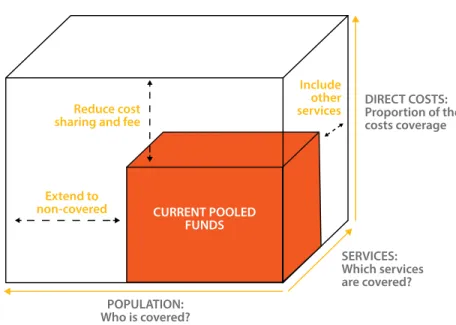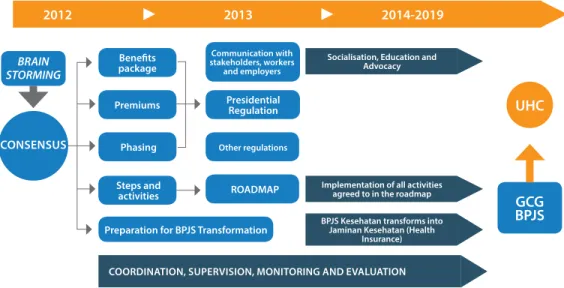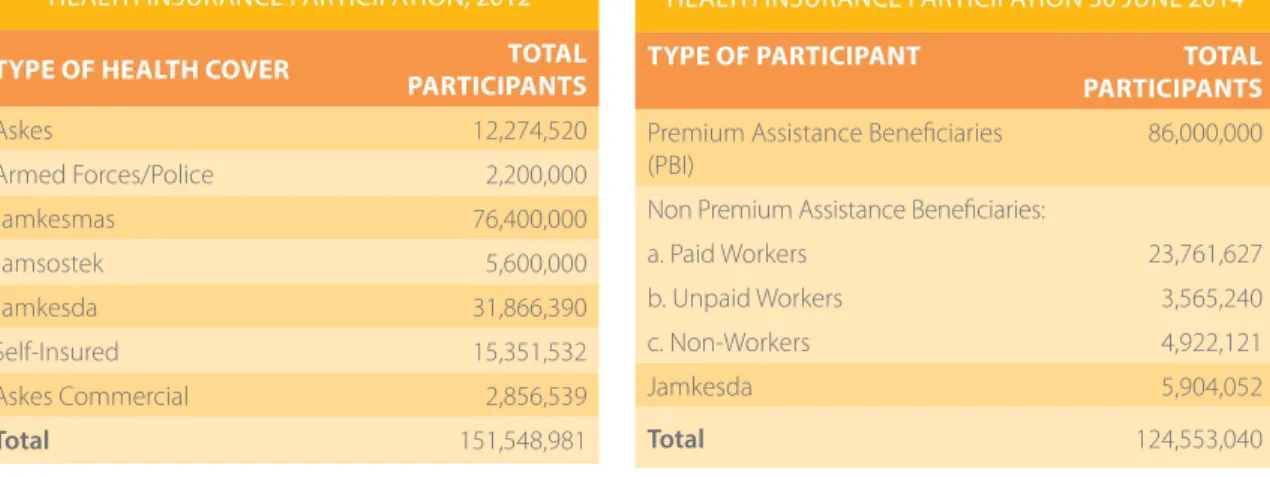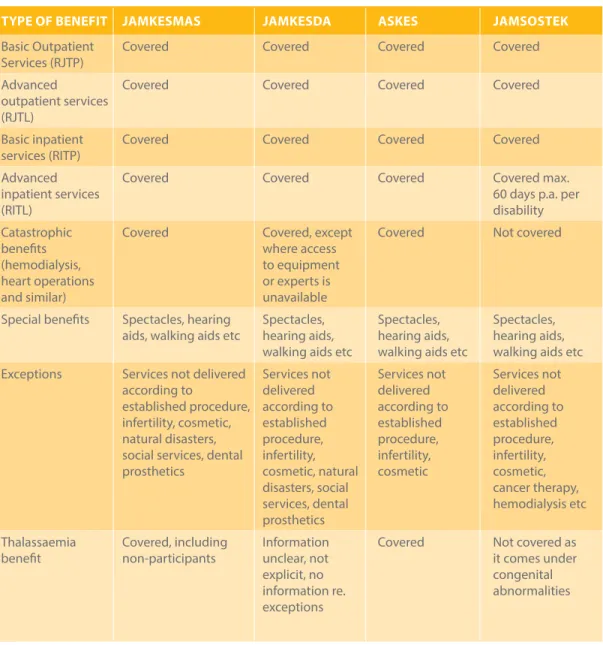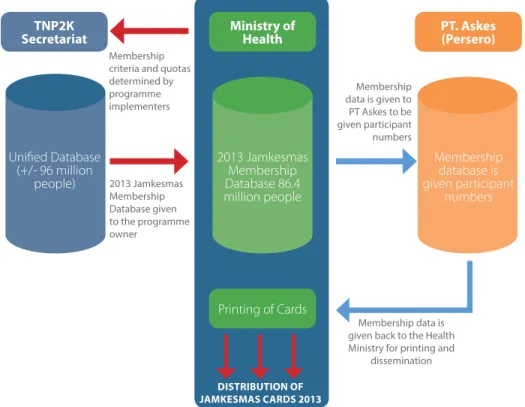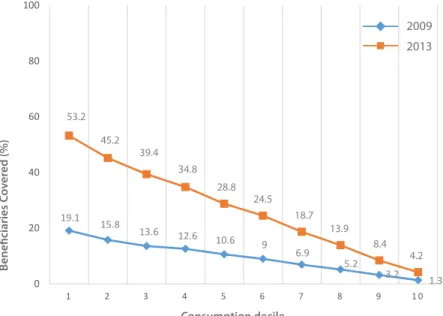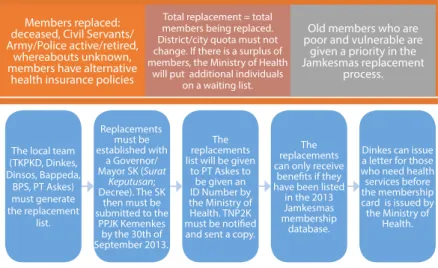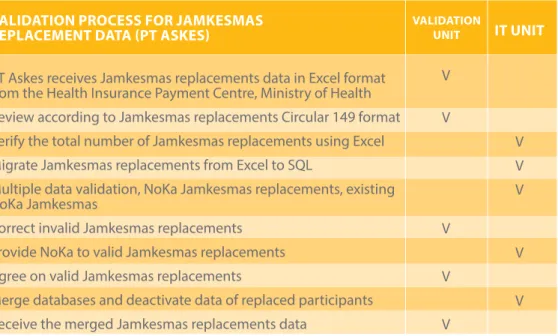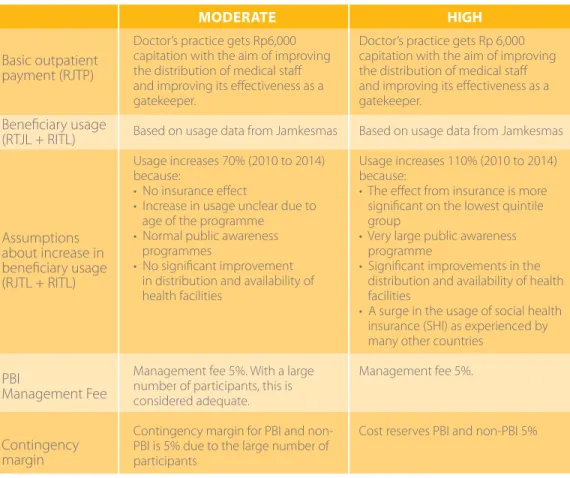Pharmaceutical policy in the social health insurance system Demand perspective – providers and consumers. In 2005, the government committed to providing health insurance to the poor with the launch of the Jamkesmas (Jaminan Kesehatan Masyarakat or Public Health Insurance) program. The Health Insurance Program for the Poor (known as Askeskin) was implemented by the Ministry of Health with the establishment of PT Askes (Persero) (Health Insurance Company) through a Ministerial Decree (SK Nomor 1241/Menkes/SK/XI/2004). .
The Road MaP
Universal healthcare coverage aims to ensure that comprehensive, high-quality healthcare services are equally accessible to the entire population. This report examines the efforts made to establish the JKN program before its implementation in early 2014, including anticipating challenges to ensure unhindered progress.
FuNdiNg
The fifth chapter examines how to increase the number of participants to full universal health coverage levels by 2019. It discusses the integration of regional health insurance with programs for participants working in the private sector, the implications of informal sector participation levels and financial assistance to the poor and vulnerable.
Choice of medicines and technologies in the JKN package of benefits Managing JKN’s package of benefits requires transparency and fairness in deciding
Currently, the National Formulary of Medicines and the List of Essential Medicines provide guidance for public sector procurement. The drug selection process should be more evidence-based and the lists should be supported by a comprehensive pricing policy for the procurement process. However, a policy framework for this needs to be developed and the capacity of the system to carry out evaluation needs to be strengthened.
Financing and the price of medicine and technology
However, these lists are not harmonized and therefore contain different items, which creates confusion, undermines the quality of the benefits package and wastes resources. Therefore, a national system to monitor the purchasing, distribution and consumption of medicines and medical technology and expenditure thereon is a priority so that a budget can be drawn up. Prescription drugs make up approximately 56.3 percent of the total drug market, consisting of branded drugs (67 percent), patented drugs (25 percent) and unbranded generics (8 percent).
Current JKN data from the private sector information management system indicates that providers are aware of pricing and purchase unbranded generics more than branded products. A political decision must be made as to whether or not the pharmaceutical market should be controlled. Several studies of brand-name generic drugs have found them relatively expensive in an international context, but the comparison did not take into account the various components of the price, including, for example, value added tax or sales tax on drugs.
It is important to avoid simplistic policies that do not take into account the entire supply chain. At the same time, the use of generic drugs should continue to be promoted among prescribers and consumers as an option to reduce drug costs. The prices, availability and performance of generic drug suppliers should continue to be monitored.
It is not clear why, but one reason may be the lack of information technology infrastructure throughout Indonesia.
Stronger management and regular monitoring of the supply chain
An efficient information management system
Yes Yes Yes Yes Yes International Median Cost (MSC) No Yes Yes 70% from public health centers Possibly - oral product - but no glucometers. ISSUERESPONSE/RATINGSOURCE Exacerbating diabetes complications Source: Hill and Santoso (2014) Note: BADAN POM = National Agency for Drug and Food Monitoring; PPH = postpartum hemorrhage; EML = Essential Medicines List; MH-SARA = Maternal Health - Service Availability and Readiness Assessment. BADAN POM Report USAID/USP PPH WHO and WHO EML guidelines Expenditure data, 2012 Interviews and consumer data from regencies Regency consumption data World Bank; WHO MH- SARA Consideration of conclusions.
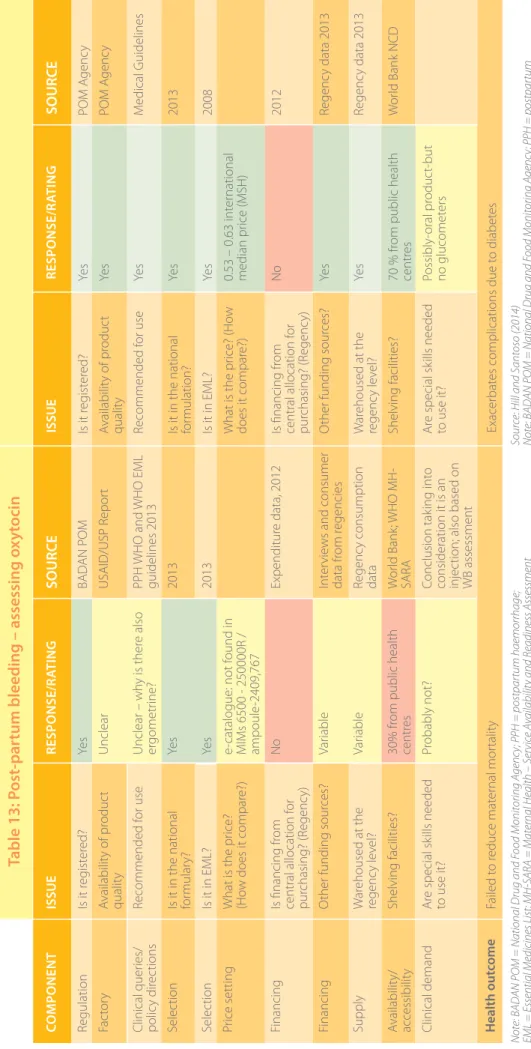
Ensuring the quality of drugs
The demand side perspective – providers and consumers
This can lead the doctor to prescribe alternative and possibly unwanted products or replace them with more expensive generic drugs, imposing a cost on patients (plus a fee for doctors). There will be an incentive for doctors and institutions to do this because of the low cap and lack of data to show that the amount actually paid is enough to cover the costs. Although laws prohibit doctors in hospitals from giving drugs directly to patients, these laws are widely ignored and unenforced.
Again, if the price of the "favored product" at procurement is lower than other available generic drugs, the proportional markup for pharmacists may encourage them to substitute with a more expensive alternative. This negative incentive to prescribe expensive products occurs because the drug price control system in Indonesia does not currently supervise all drug prices, only a part of them. It is unclear whether the funds available in hospitals will be enough to cover drugs.
Successful management of medicines and their costs in hospitals using diagnosis-related groups requires, among other strategies, a National Committee on Medicines and Therapies to ensure correct prescribing. At the time, they were required to file claims using an electronic system, but currently it is estimated that only 20 percent of hospitals have information technology systems, and they are often different. The Vice President's Secretariat, responding to the results of TNP2K's analysis, was instrumental in these changes.
In the future, many issues need to be addressed in order to optimize the implementation of JKN in order to achieve universal health coverage by 2019.
A strategy for sustainability
New sources of revenue: creating fiscal capacity
There have been new refined calculations for PBI obligations, the information management system has been strengthened, funds in health centers have been managed more rigorously, as well as chapter payments to hospitals. The application of health tobacco excise, which can be increased every year for the next five years. Whether divided or not, the tobacco tax would raise revenue, reduce smoking prevalence, cut health care costs, and increase worker productivity.
The fuel subsidy alone was equivalent to $32 billion in early 2013 and $20 billion in early 2014. The government can generate new revenue while increasing both equity and progressivity by imposing the tax on middle-income community groups high;. However, private workers should be excluded and any impact on small and medium enterprises should be minimized as they are the engine of future economic growth.
Increasing efficiency in the current system by tackling corruption, reducing the number of inaccurate diagnoses, reducing the number of unnecessary hospital admissions (strengthening the referral system in Level I healthcare institutions), regulating pharmaceutical expenditure and bribery and to eliminate corruption in the procurement of medicines. facilities and health equipment. More effectively allocating government spending on health care in BPJS's overall budget is also important to ensure that public health financing benefits the poor. For example, the distribution key for primary care is only 15 percent of the total budget.
Could this figure increase to 20-30 percent next year, in line with the increased provision for poor and underserved regions.
Expanding membership
Readiness of the supply side
This will provide a better understanding of what is happening in both public and private hospitals. In the short term, the government may update the "dynamic supply and demand system" model developed by TNP2K for the JKN program. This model was useful at the beginning of the program and can be updated with actual claims data from BPJS from the first six to nine months of the program.
TNP2K is currently developing a needs-based supply-side assessment model at the provincial level. In the medium term, the government should consider targets for the provision of health services between 2015 and 2019. The indicators will be largely based on WHO recommendations suitable for Indonesia, and the proposed targets will be based on the achievement of fundamental steps towards universal health care. in 2019.
Anticipate and disseminate supply-side needs in terms of facilities, resources and management, and establish an independent organization to oversee the accreditation of public and private facilities. increase accountability through independent and effective monitoring and evaluation systems to ensure readiness of services and provision, especially for the poor and vulnerable; Create a “master plan” to unify and align the public and private health sectors and establish a health care organization that reflects the shift.
Improve public sector funding, budgeting processes and health investment targeting, as well as the connection between the different levels of government to secure the supply side.
Pharmaceutical policy in the social health insurance system
While PT Askes offers a good pharmaceutical model for social health insurance in Indonesia, scaling up this approach may result in high pharmaceutical spending (and use) during the transition to universal health coverage. The National Formulary of Drugs, which contains the full list of drugs to be supplied in a health facility, was prepared and adopted in 2013 through a ministerial decree. This forms the basis for the use of medicinal products in the national healthcare system from 2014.
Also, the Essential Medicines List, a new electronic catalog of medicine and technology, was developed. Although it was based on the formulary, due to the tendering process involved, not all drugs are included, but it does include brands and prices, making it possible to order drugs online. The choice of medicines and technologies to be included in the JKN package of benefits.
Information management system requirements
Drugs and quality assurance
The demand side perspective: providers and consumers
Pemaparan Menteri Kesehatan pada rapat pembahasan progres persiapan penyelenggaraan Jaminan Kesehatan Nasional, Jakarta, 12 Desember. Rencana Aksi Pembangunan Pelayanan Kesehatan Edisi Singkat 2013-2019 (Rencana Aksi Pembangunan Pelayanan Kesehatan. Kajian Paket Biaya dan Manfaat Cakupan Kesehatan Nasional).
Mengukur paket manfaat yang tepat untuk ketahanan kesehatan nasional (Mengembangkan paket manfaat untuk ketahanan kesehatan nasional). Panduan teknis penggunaan alat untuk menghitung iuran Jaminan Kesehatan Nasional penerima bantuan iuran). Bimbingan teknis penghitungan estimasi iuran JKN PBI (Bimbingan teknis estimasi iuran penerima bantuan iuran jaminan kesehatan nasional).
National Team for the Acceleration of Poverty Reduction. National Team for the Acceleration of Poverty Reduction (TNP2K). National Team for the Acceleration of Poverty Reduction (TNP2K).2013 Assessing the gap between medical care demand and treatment capacity. Impact of smoking on annual economic consequences in Indonesia: The cost of treating tobacco-related diseases in Indonesia.
Southeast Asian Initiative on Tobacco Tax (SITT) of the Southeast Asian Tobacco Control Association (SEATCA).
NATIONAL TEAM fOr ThE AccELErATION Of pOvErTy rEducTION
Secretariat of the vice president of the republic of Indonesia
